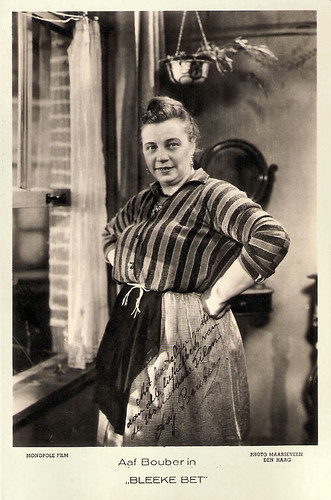
Dutch postcard by M.B. & Z. (M. Bonnist & Zonen, Amsterdam). Photo: Dick van Maarseveen, Den Haag / Monopole Film. Aaf Bouber in Bleeke Bet (Alex Benno, Richard Oswald, 1934). Collection: Geoffrey Donaldson Institute.

Dutch postcard by Monopole Film, Rotterdam. Photo: Dick van Maarseveen. Jopie Koopman in Bleeke Bet (Alex Benno, Richard Oswald, 1934). Collection: Geoffrey Donaldson Institute.
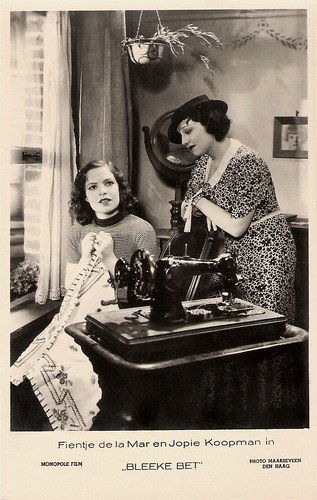
Dutch postcard by Monopole Film, Rotterdam. Photo: Dick van Maarseveen. Fien de la Mar and Jopie Koopman in Bleeke Bet (Alex Benno, Richard Oswald, 1934).
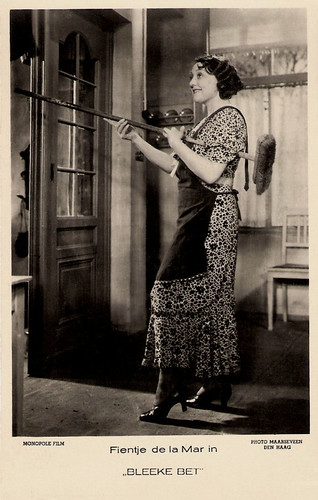
Dutch postcard by M.B. & Z. (M. Bonnist & Zonen, Amsterdam). Photo: Monopole Film / Dick van Maarseveen, Den Haag. Fien(tje) de la Mar in Bleeke Bet (Alex Benno, Richard Oswald, 1934).
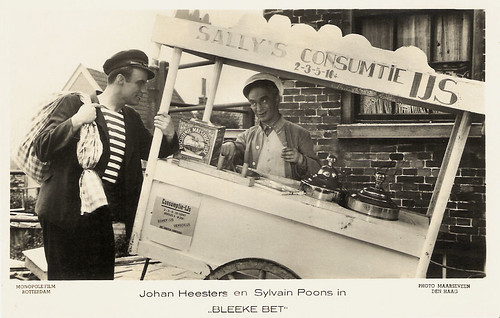
Dutch postcard by Monopole Film, Amsterdam. Photo: Dick van Maarseveen, Den Haag. Sylvain Poons and Johan Heesters in Bleeke Bet (Richard Oswald, Alex Benno, 1934). Collection: Geoffrey Donaldson Institute.
A greengrocer in the Jordaan
The directors of Bleeke Bet/Pale Betty (1934) were Alex Benno, who had already directed several silent Dutch films and the Austrian director, producer, and screenwriter Richard Oswald.
From 1914 on, Oswald made dozens of films in Weimar Germany, including the comedy Der Hauptmann von Köpenick/The Captain from Köpenick (1931) and the horror-comedy Unheimliche Geschichten/Uncanny Stories (1932) starring Paul Wegener. Being Jewish, Oswald was forced to flee Nazi Germany, first for occupied France and later emigrating to the United States.
Alex Benno had also written the screenplay for Bleeke Bet. It was based on a popular stage melodrama, written by Herman Bouber in 1917. Benno and Bouber made a silent version of Bleeke Bet in 1923 with Alida van Gijtenbeek as Bet. After the amazing box office success of the sound film De Jantjes/The Tars (Jaap Speyer, 1933), also based on a play by Bouber, Benno got the green light for a sound version of Bleeke Bet.
In the new sound version, Bouber's wife, Aaf Bouber, played the title role of Bleeke Bet, a greengrocer in the Jordaan, the old neighbourhood in the heart of Amsterdam. Bet wants her daughter Jans (Jopie Koopman) to marry the son of a dodgy businessman, but Jans loves sailor Ko (the young Johannes Heesters).
Bet's attempts to drive them apart come to nothing but when Ko is reported lost at sea, a desperate Jans gives in to her mother's wishes. On the wedding day, Ko turns out to be alive and just in time to take his rightful place at the altar next to Jans. The still on the last postcard of this post shows the happy ending with Fien de la Mar as Ka in the centre.
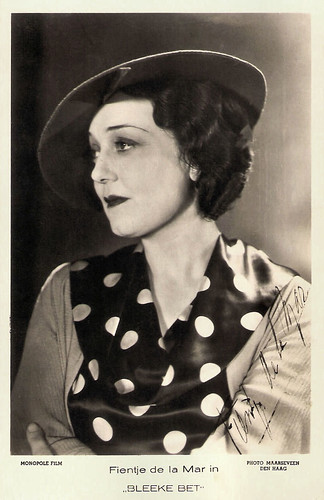
Dutch postcard by M.B. & Z. (M. Bonnist & Zonen, Amsterdam). Photo: Dick van Maarseveen, Den Haag / Monopole Film. Fien(tje) de la Mar in Bleeke Bet (1934, Alex Benno, Richard Oswald). Collection: Geoffrey Donaldson Institute.
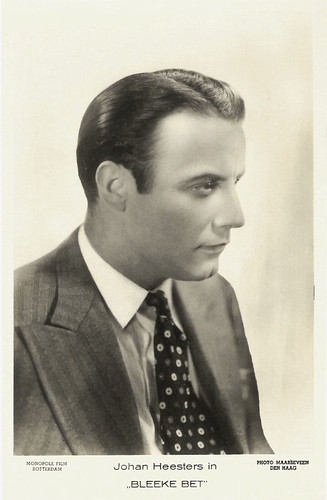
Dutch postcard by M. B. & Z. (M. Bonnist & Zonen, Amsterdam). Photo: Monopole Film, Rotterdam / Maarseveen, Den Haag. Johan(nes) Heesters in Bleeke Bet (1934).
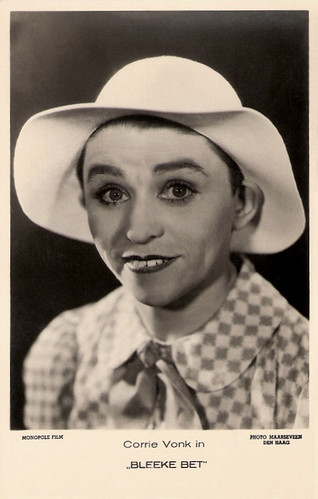
Dutch postcard by M.B. & Z. (M. Bonnist & Zonen, Amsterdam). Photo: Monopole Film / Dick van Maarseveen, Den Haag. Corrie Vonk in Bleeke Bet (Alex Benno, Richard Oswald, 1934).

Dutch postcard by M.B. & Z. (M. Bonnist & Zonen, Amsterdam). Photo: Dick van Maarseveen, Den Haag / Monopole Film. Johan Elsensohn in Bleeke Bet (1934). Collection: Geoffrey Donaldson Institute.
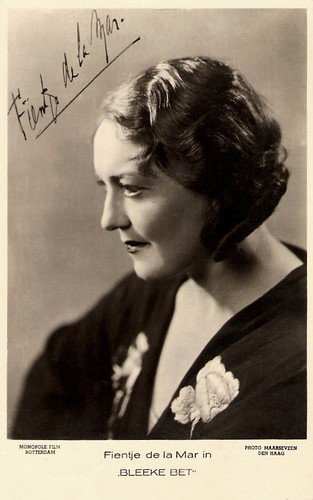
Dutch Postcard by Monopole Film, Rotterdam. Photo: Dick van Maarseveen, Den Haag. Fien de la Mar in Bleeke Bet (1934).
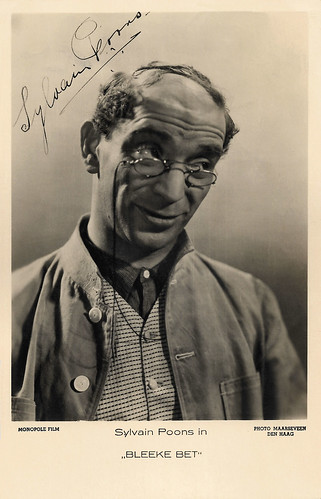
Dutch postcard by Monopole Film, Rotterdam. Photo: Dick van Maarseveen, Den Haag. Sylvain Poons in Bleeke Bet (1934).
Nazi censors
Bleeke Bet was a commercial success and would be re-issued in 1941 and 1961. In 1941 Jewish actors like Sylvain Poons were cut out of the picture by the Nazi censors.
Poons as the ice cream salesman Sally sings an evergreen in the film, 'IJslied' (Ice cream Song). The music was composed by emigrant Hans May and the lyrics were written by the later collaborator, Jacques van Tol.
The film has more wonderful songs, including Fien de la Mar's torch song 'Ik wil gelukkig zijn' (I want to be happy).
Fien de la Mar, Sylvain Poons and Johan Elsensohn as Bet's husband got positive reviews in the Dutch newspapers for their performances. The voice of Johannes Heesters was also complimented.
However, the film's reviews were mixed, but it did not matter to the producer: the public loved it.
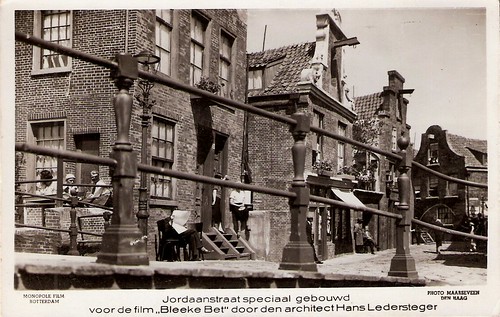
Dutch postcard by Monopole Film, Rotterdam. Photo: Dick van Maarseveen. Still of a set built for Bleeke Bet (Alex Benno, Richard Oswald, 1934), a street in the old neighbourhood De Jordaan in Amsterdam. Set designer was Hans Ledersteger. The set would be used again for several other films.

Dutch postcard by Monopole Film. Photo: Maarseveen, Den Haag. Fien(tje) de la Mar and Jopie Koopman in Bleeke Bet (Alex Benno, Richard Oswald, 1934).
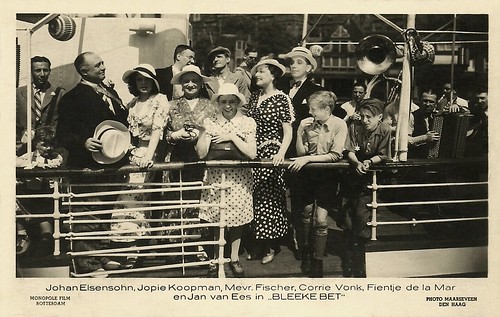
Dutch postcard by Monopole Film, Amsterdam. Photo: Maarseveen, Den Haag. Johan Elsensohn, Jopie Koopman, Clara Vischer-Blaaser, Corry Vonk, Fien de la Mar and Jan van Ees in Bleeke Bet (Richard Oswald, Alex Benno, 1934).
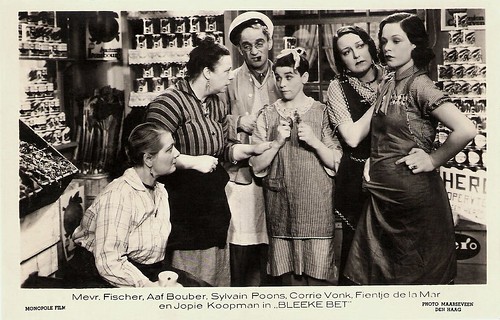
Dutch postcard by Monopole Film, Amsterdam. Photo: Maarseveen, Den Haag. Clara Vischer-Blaaser, Aaf Bouber, Sylvain Poons, Corry Vonk, Fien de la Mar and Jopie Koopman in Bleeke Bet (Richard Oswald, Alex Benno, 1934).
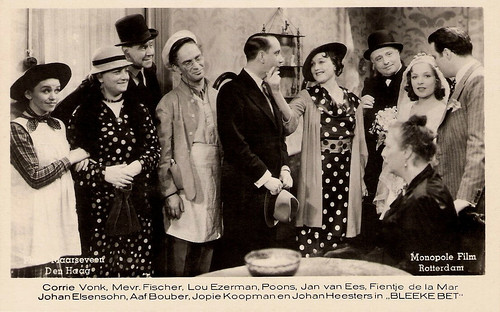
Dutch Postcard by Monopole Film, Rotterdam. Photo: Dick van Maarseveen, Den Haag (The Hague). Publicity still for Bleeke Bet (1934) with the main cast for the happy ending.

Dutch postcard by Monopole Film, Rotterdam. Photo: Dick van Maarseveen, Den Haag. Johan(nes) Heesters in Bleeke Bet (Richard Oswald, Alex Benno, 1934).
Sources: Wikipedia (Dutch and English) and IMDb.
No comments:
Post a Comment